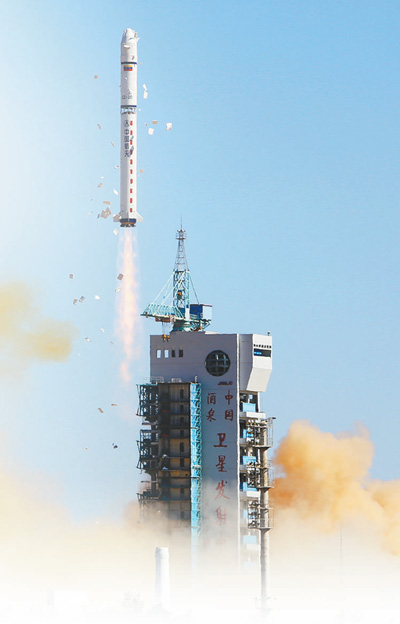


A bird's-eye view of the Jiuquan Satellite Launch Center (Photo/Jiuquan Satellite Launch Center)
Jiuquan Satellite Launch Center (JSLC), China’s first and largest comprehensive space mission launch center, as well as the only manned space flight launch center in China, has witnessed many firsts and major achievements in China’s space exploration.
On Nov. 5, 1960, the first Chinese-made ground-to-ground missile was successfully launched from JSLC, marking an important turning point in the course of China’s endeavors to push back the frontiers of science and technology for national security.
On Oct. 27, 1966, China’s first experiment on the combination of missile technology with atomic bombs succeeded in JSLC.
On April 24, 1970, China successfully launched its first satellite, Dongfanghong-1, into orbit from JSLC, which signified that China now had its own satellite technology.
On Nov. 26, 1975, China’s first recoverable satellite was successfully launched from JSLC, marking the point when China had mastered the technologies required to send space crafts into space and retrieve them from space.

(Photo/Jiuquan Satellite Launch Center)
On May 18, 1980, China’s first long-range carrier rocket was successfully launched from JSLC, signifying China’s capability to launch long-range strikes.
On Sept. 20, 1981, China successfully launched a set of three satellites with one carrier rocket from JSLC.
On Nov. 20, 1999, China’s experimental Shenzhou-1 unmanned spacecraft was successfully sent into orbit from JSLC, marking the start of China’s manned space flight project.
On Oct. 15, 2003, Shenzhou-5, China’s first manned space vehicle carrying Chinese astronaut Yang Liwei, was launched into space from JSLC, realizing what had been a dream of Chinese people for thousands years: sending humans into space.
On Sept. 25, 2008, China’s Shenzhou-7 manned spacecraft was sent into space from JSLC. Chinese astronaut Zhai Zhigang finished an extravehicular task and performed a historic spacewalk, which made China the third country in the world to send astronaut into space and perform a spacewalk.
On Sept. 29, 2011, Tiangong-1, China’s first experimental space lab, was launched into space from JSLC, which later successfully rendezvoused and docked with Shenzhou-8 and Shenzhou-9 spacecrafts respectively, thereby marking China’s capability to realize space rendezvous and docking.
On Dec. 17, 2015, China’s first dark matter detection satellite “Wukong” (Monkey King) was launched from JSLC, marking a significant step for China in the ongoing process of deep space exploration.

Workers build railways in the early stage of the center's development. (Photo/Jiuquan Satellite Launch Center)
On Aug.16, 2016, the world’s first quantum science satellite Mozi was sent into space from JSLC, representing a major breakthrough in China’s exploration of space science.
On Sept.15, 2016, China’s first space lab, Tiangong-2, was sent into space from JSLC, which signified significant progress in China’s space exploration, meaning the country would be able to realize medium-term stays in space.
Built in 1958 and located in Jiuquan City of northwest China’s Gansu Province, JSLC is the earliest of the four space mission launch sites in China. JSLC is mainly used to launch spacecrafts into medium and lower earth orbits and sun-synchronous orbits.
 Fire brigade in Shanghai holds group wedding
Fire brigade in Shanghai holds group wedding Tourists enjoy ice sculptures in Datan Town, north China
Tourists enjoy ice sculptures in Datan Town, north China Sunset scenery of Dayan Pagoda in Xi'an
Sunset scenery of Dayan Pagoda in Xi'an Tourists have fun at scenic spot in Nanlong Town, NW China
Tourists have fun at scenic spot in Nanlong Town, NW China Harbin attracts tourists by making best use of ice in winter
Harbin attracts tourists by making best use of ice in winter In pics: FIS Alpine Ski Women's World Cup Slalom
In pics: FIS Alpine Ski Women's World Cup Slalom Black-necked cranes rest at reservoir in Lhunzhub County, Lhasa
Black-necked cranes rest at reservoir in Lhunzhub County, Lhasa China's FAST telescope will be available to foreign scientists in April
China's FAST telescope will be available to foreign scientists in April "She power" plays indispensable role in poverty alleviation
"She power" plays indispensable role in poverty alleviation Top 10 world news events of People's Daily in 2020
Top 10 world news events of People's Daily in 2020 Top 10 China news events of People's Daily in 2020
Top 10 China news events of People's Daily in 2020 Top 10 media buzzwords of 2020
Top 10 media buzzwords of 2020 Year-ender:10 major tourism stories of 2020
Year-ender:10 major tourism stories of 2020 No interference in Venezuelan issues
No interference in Venezuelan issues
 Biz prepares for trade spat
Biz prepares for trade spat
 Broadcasting Continent
Broadcasting Continent Australia wins Chinese CEOs as US loses
Australia wins Chinese CEOs as US loses